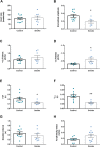Smoking flies: testing the effect of tobacco cigarettes on heart function of Drosophila melanogaster
- PMID: 33431431
- PMCID: PMC7903996
- DOI: 10.1242/bio.055004
Smoking flies: testing the effect of tobacco cigarettes on heart function of Drosophila melanogaster
Abstract
Studies about the relationship between substances consumed by humans and their impact on health, in animal models, have been a challenge due to differences between species in the animal kingdom. However, the homology of certain genes has allowed extrapolation of certain knowledge obtained in animals. Drosophila melanogaster, studied for decades, has been widely used as model for human diseases as well as to study responses associated with the consumption of several substances. In the present work we explore the impact of tobacco consumption on a model of 'smoking flies'. Throughout these experiments, we aim to provide information about the effects of tobacco consumption on cardiac physiology. We assessed intracellular calcium handling, a phenomenon underlying cardiac contraction and relaxation. Flies chronically exposed to tobacco smoke exhibited an increased heart rate and alterations in the dynamics of the transient increase of intracellular calcium in myocardial cells. These effects were also evident under acute exposure to nicotine of the heart, in a semi-intact preparation. Moreover, the alpha 1 and 7 subunits of the nicotinic receptors are involved in the heart response to tobacco and nicotine under chronic (in the intact fly) as well as acute exposure (in the semi-intact preparation). The present data elucidate the implication of the intracellular cardiac pathways affected by nicotine on the heart tissue. Based on the probed genetic and physiological similarity between the fly and human heart, cardiac effects exerted by tobacco smoke in Drosophila advances our understanding of the impact of it in the human heart. Additionally, it may also provide information on how nicotine-like substances, e.g. neonicotinoids used as insecticides, affect cardiac function.This article has an associated First Person interview with the first author of the paper.
Keywords: Downregulation; Drosophila; Heart; Nicotine; Receptors; Tobacco.
© 2021. Published by The Company of Biologists Ltd.
Conflict of interest statement
Competing interestsThe authors declare no competing or financial interests.
Figures







References
-
- De Castro, C., Titlow, J., Majeed, Z. R. and Cooper, R. L. (2014). Analysis of various physiological salines for heart rate, CNS function, and synaptic transmission at neuromuscular junctions in Drosophila melanogaster larvae. J. Comp. Physiol. A Neuroethol. Sens. Neural Behav. Physiol. 200, 83-92. 10.1007/s00359-013-0864-0 - DOI - PubMed
Publication types
MeSH terms
Substances
LinkOut - more resources
Full Text Sources
Other Literature Sources
Medical
Molecular Biology Databases

